Any Kind of Animals That Live in Africa Baby Puppies for Sale

A pet, or companion animal, is an animal kept primarily for a person'due south company or entertainment rather than equally a working animal, livestock or a laboratory beast. Popular pets are often considered to accept attractive appearances, intelligence and relatable personalities, but some pets may be taken in on an altruistic basis (such as a stray beast) and accepted by the owner regardless of these characteristics.
Ii of the near popular pets are dogs and cats. Other animals commonly kept include: rabbits; ferrets; pigs; rodents, such equally gerbils, hamsters, chinchillas, rats, mice, and republic of guinea pigs; avian pets, such as parrots, passerines and fowls; reptile pets, such as turtles, alligators, crocodiles, lizards, and snakes; aquatic pets, such as fish, freshwater and saltwater snails, amphibians similar frogs and salamanders; and arthropod pets, such equally tarantulas and hermit crabs. Pocket-size pets may exist grouped together equally pocket pets, while the equine and bovine group include the largest companion animals.
Pets provide their owners (or "guardians")[i] both concrete and emotional benefits. Walking a dog tin provide both the human and the dog with exercise, fresh air and social interaction. Pets tin give companionship to people who are living alone or elderly adults who practise not have acceptable social interaction with other people. There is a medically canonical grade of therapy animals, by and large dogs or cats, that are brought to visit bars humans, such as children in hospitals or elders in nursing homes. Pet therapy utilizes trained animals and handlers to attain specific physical, social, cerebral or emotional goals with patients.

People most commonly get pets for companionship, to protect a abode or property or because of the perceived beauty or bewitchery of the animals.[ii] A 1994 Canadian study found that the most mutual reasons for not owning a pet were lack of power to intendance for the pet when traveling (34.six%), lack of time (28.half-dozen%) and lack of suitable housing (28.3%), with dislike of pets being less mutual (xix.6%).[2] Some scholars, ethicists and creature rights organizations have raised concerns over keeping pets because of the lack of autonomy and the objectification of non-human animals.[3]
Pet popularity
China
In Red china, spending on domestic animals has grown from an estimated $iii.12 billion in 2010 to $25 billion in 2018. The Chinese people own 51 million dogs and 41 million cats, with pet owners oft preferring to source pet food internationally.[iv] There are a total of 755 million pets, increased from 389 million in 2013.[v]
Italy
According to a survey promoted by Italian family associations in 2009, information technology is estimated that there are approximately 45 million pets in Italian republic. This includes seven million dogs, 7.5 million cats, 16 million fish, 12 million birds, and x one thousand thousand snakes.[6]
United Kingdom
A 2007 survey by the University of Bristol institute that 26% of UK households owned cats and 31% owned dogs, estimating total domestic populations of approximately ten.three one thousand thousand cats and x.5 million dogs in 2006.[seven] The survey also establish that 47.ii% of households with a cat had at least one person educated to degree level, compared with 38.iv% of homes with dogs.[viii]
United States
Lx-8 per centum of U.Due south. households, or almost 85 1000000 families, own a pet, co-ordinate to the 2017-2018 National Pet Owners Survey conducted by the American Pet Products Clan (APPA). This is up from 56 percentage of U.Due south. households in 1988, the first twelvemonth the survey was conducted.[9] There are approximately 86.4 million pet cats and approximately 78.2 million pet dogs in the United States,[ten] [11] and a United States 2007–2008 survey showed that canis familiaris-owning households outnumbered those owning cats, but that the total number of pet cats was higher than that of dogs. The aforementioned was true for 2011.[12] In 2013, pets outnumbered children four to one in the United States.[13]
-
Most popular pets in the U.S (millions)[xiv] [15] Pet Global population U.S. population U.Due south. inhabited households U.Southward. average per inhabited household Cat 202 93.6 38.2 2.45 Dog 171 77.five 45.six one.lxx Fish N/A 171.7 13.3 12.86 Small mammals Northward/A 15.9 5.3 three.00 Birds North/A 15.0 6.0 ii.50 Reptiles & amphibians N/A thirteen.6 four.seven two.89 Equine North/A 13.3 3.9 3.41
Effects on pets' health
Keeping animals as pets may be detrimental to their health if certain requirements are non met. An important event is inappropriate feeding, which may produce clinical furnishings. The consumption of chocolate or grapes past dogs, for instance, may prove fatal.
Sure species of houseplants can too show toxic if consumed by pets. Examples include philodendrons and Easter lilies (which tin can cause severe kidney damage to cats)[16] [17] and poinsettias, begonia, and aloe vera (which are mildly toxic to dogs).[xviii] [19]
Housepets, specially dogs and cats in industrialized societies, are also highly susceptible to obesity. Overweight pets accept been shown to be at a higher risk of developing diabetes, liver problems, joint pain, kidney failure, and cancer. Lack of practise and high-caloric diets are considered to be the primary contributors to pet obesity.[20] [21] [22]
Effects of pets on their caregiver's health

A couple with their pet dog

Adult female jogging with a canis familiaris at Carcavelos beach, Portugal
Health benefits
It is widely believed among the public, and amongst many scientists, that pets probably bring mental and concrete wellness benefits to their owners;[23] a 1987 NIH statement cautiously argued that existing data was "suggestive" of a significant benefit.[24] A contempo dissent comes from a 2017 RAND study, which found that at to the lowest degree in the instance of children, having a pet per se failed to amend physical or mental wellness by a statistically pregnant amount; instead, the study found children who were already prone to being salubrious were more likely to get pets in the outset place.[23] [25] [26] Unfortunately, conducting long-term randomized trials to settle the issue would be plush or infeasible.[24] [26]
Observed correlations
Pets might take the power to stimulate their caregivers, in particular the elderly, giving people someone to take care of, someone to practice with, and someone to help them heal from a physically or psychologically troubled past.[24] [27] [28] Beast company tin also aid people to preserve acceptable levels of happiness despite the presence of mood symptoms like anxiety or low.[29] Having a pet may also assist people achieve wellness goals, such as lowered blood pressure, or mental goals, such every bit decreased stress.[30] [31] [32] [33] [34] [35] There is evidence that having a pet can aid a person atomic number 82 a longer, healthier life. In a 1986 study of 92 people hospitalized for coronary ailments, within a twelvemonth, 11 of the 29 patients without pets had died, compared to only 3 of the 52 patients who had pets.[28] Having pet(s) was shown to significantly reduce triglycerides, and thus heart disease gamble, in the elderly.[36] A study by the National Constitute of Wellness establish that people who owned dogs were less likely to die every bit a result of a center assail than those who did non own one.[37] There is some show that pets may have a therapeutic effect in dementia cases.[38] Other studies have shown that for the elderly, good health may exist a requirement for having a pet, and not a effect.[39] Dogs trained to exist guide dogs can assist people with vision impairment. Dogs trained in the field of Creature-Assisted Therapy (AAT) can also benefit people with other disabilities.[24] [40]
Pets in long-term care institutions
People residing in a long-term care facility, such as a hospice or nursing dwelling house, may feel health benefits from pets. Pets help them to cope with the emotional problems related to their affliction. They also offer physical contact with another living creature, something that is ofttimes missing in an elder's life.[x] [41] Pets for nursing homes are called based on the size of the pet, the amount of care that the breed needs, and the population and size of the care establishment.[28] Advisable pets go through a screening process and, if it is a dog, additional training programs to become a therapy canis familiaris.[42] In that location are three types of therapy dogs: facility therapy dogs, animal-assisted therapy dogs, and therapeutic visitation dogs. The virtually common therapy dogs are therapeutic visitation dogs. These dogs are household pets whose handlers take fourth dimension to visit hospitals, nursing homes, detention facilities, and rehabilitation facilities.[27] Different pets crave varying amounts of attention and care; for example, cats may have lower maintenance requirements than dogs.[43]
In improver to providing health benefits for their owners, pets as well touch on the social lives of their owners and their connection to their community. In that location is some testify that pets tin facilitate social interaction.[44] Assistant Professor of Sociology at the University of Colorado at Bedrock, Leslie Irvine has focused her attention on pets of the homeless population. Her studies of pet buying among the homeless found that many modify their life activities for fear of losing their pets. Pet ownership prompts them to act responsibly, with many making a deliberate choice non to drink or use drugs, and to avoid contact with substance abusers or those involved in whatsoever criminal activity for fright of being separated from their pet. Additionally, many refuse to business firm in shelters if their pet is not allowed to stay with them.[45]
Wellness risks
Health risks that are associated with pets include:
- Aggravation of allergies and asthma caused by dander and fur or feathers
- Falling injuries. Tripping over pets, specially dogs causes more than 86,000 falls serious enough to prompt a trip to the emergency room each year in the United states.[46] Amongst elderly and disabled people, these falls have resulted in life-threatening injuries and broken bones.
- Injury, mauling, and sometimes death acquired past pet bites and attacks
- Affliction or parasites due to animal hygiene problems, lack of appropriate treatment, and undisciplined behavior (feces and urine)
- Stress acquired by the beliefs of animals
- Anxiety over who will care for the animal should the owner no longer be able to do so
Legislation
Treaties
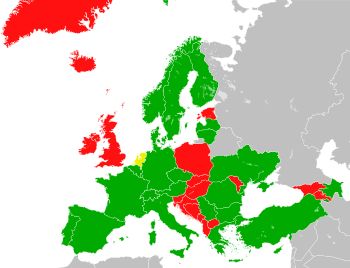
| Signed and ratified | Acceded or succeeded | ||
| Merely signed | Not signed (CoE member states) | ||
| Not signed (non-CoE member states) |
The European Convention for the Protection of Pet Animals is a 1987 treaty of the Council of Europe – only accession to the treaty is open to all states in the globe – to promote the welfare of pet animals and ensure minimum standards for their treatment and protection. It went into result on 1 May 1992, and every bit of June 2020, it has been ratified by 24 states.[47]
National and local laws
The keeping of animals as pets can cause concerns with regard to brute rights and welfare.[48] [49] [l]
Ownership or guardianship
Pets have ordinarily been considered private property, owned by private persons. However, many legal protections have existed (historically and today) with the intention of safeguarding pets' (and other animals') well-being.[51] [52] [53] [54] Since the twelvemonth 2000, a small but increasing number of jurisdictions in Due north America have enacted laws redefining pet'due south owners as guardians. Intentions have been characterized as merely changing attitudes and perceptions (but not legal consequences) to working toward legal personhood for pets themselves. Some veterinarians and breeders take opposed these moves. The question of pets' legal status can arise with concern to purchase or adoption, custody, divorce, estate and inheritance, injury, damage, and veterinary malpractice.[55] [56] [57] [58]
Limitations on species
States, cities, and towns in Western countries usually enact local ordinances to limit the number or kind of pets a person may keep personally or for business purposes. Prohibited pets may be specific to certain breeds (such as pit bulls or Rottweilers), they may utilize to full general categories of animals (such as livestock, exotic animals, wild animals, and canid or felid hybrids), or they may simply be based on the animal's size. Additional or different maintenance rules and regulations may also employ. Condominium associations and owners of rental properties besides usually limit or forbid tenants' keeping of pets.[ commendation needed ]
In Belgium and holland, the regime publishes white lists and black lists (chosen 'positive' and 'negative lists') with brute species that are designated to be advisable to exist kept as pets (positive) or not (negative). The Dutch Ministry of Economic Diplomacy and Climate Policy originally established its get-go positive list (positieflijst) per 1 Feb 2015 for a set of 100 mammals (including cats, dogs and production animals) deemed appropriate as pets on the recommendations of Wageningen University.[59] Parliamentary debates virtually such a pet list appointment back to the 1980s, with continuous disagreements well-nigh which species should exist included and how the law should be enforced.[60] In January 2017, the white list was expanded to 123 species, while the black list that had been set was expanded (with animals like the brown bear and ii great kangaroo species) to comprise 153 species unfit for petting, such as the armadillo, the sloth, the European hare and the wild boar.[61]
Killing and eating pets
In Jan 2011, the Belgian Federal Agency for the Safety of the Food Concatenation stated that people are not allowed to kill random cats walking in their garden, but '[n]owhere in the law does it say that you lot can't eat your true cat, dog, rabbit, fish or whatever. You merely have to kill them in an animal-friendly way.'[62] Since ane July 2014, it is illegal in holland for owners to kill their ain cats and dogs kept every bit pets. Parakeets, republic of guinea pigs, hamsters and other animals may still exist killed by their owners, only nonetheless when owners mistreat their companion animals (for example, in the procedure of killing them), the owners tin however be prosecuted under Dutch law.[63]
Environmental impact
Pets accept a considerable ecology impact, specially in countries where they are mutual or held in high densities. For example, the 163 million dogs and cats kept in the Us consume about 20% of the corporeality of dietary free energy that humans do and an estimated 33% of the animal-derived energy.[64] They produce virtually 30% ± 13%, by mass, as much feces as Americans, and through their diet, constitute almost 25–30% of the ecology impacts from animal production in terms of the use of state, water, fossil fuel, phosphate, and biocides. Canis familiaris and cat animal product consumption is responsible for the release of up to 64 ± sixteen 1000000 tons COii-equivalent methane and nitrous oxide, two powerful greenhouse gasses. Americans are the largest pet owners in the world, but pet ownership in the US has considerable environmental costs.[64]
Types


The red play a trick on was only recently domesticated.
While many people take kept many different species of animals in captivity over the course of man history, just a relative few have been kept long enough to exist considered domesticated. Other types of animal, notably monkeys, have never been domesticated simply are still sold and kept equally pets. There are also inanimate objects that have been kept as "pets", either as a form of a game or humorously (e.g. the Pet Rock or Chia Pet). Some wild animals are kept as pets, such equally tigers, even though this is illegal. There is a market for illegal pets.
Domesticated
Domesticated pets are well-nigh common. A domesticated animate being is a species that has been fabricated fit for a man environment[65] by beingness consistently kept in captivity and selectively bred over a long plenty period of time that it exhibits marked differences in beliefs and appearance from its wild relatives. Domestication contrasts with taming, which is simply when an un-domesticated, wild animal has become tolerant of human presence, and perhaps, even enjoys it.
Mammals




Sharing a bed with a Yorkshire terrier
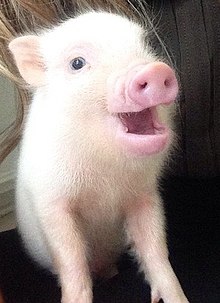
- Alpacas
- Camels
- Cats
- Cattle
- Dogs
- Donkeys
- Ferrets
- Goats
- Hedgehogs
- Horses
- Llamas
- Monkeys
- Pigs
- Rabbits
- Red foxes
- Rodents as pets, including rats, mice, hamsters, guinea pigs, gerbils, and chinchillas
- Sheep
- Carbohydrate gliders
Birds


- Companion parrots, like the budgie and cockatiel.
- Fowl, such as chickens, turkeys, ducks, geese and quails
- Columbines
- Passerines, namely finches and canaries
Fish
- Goldfish
- Koi
- Siamese fighting fish (Betta)
- Barb
- Guppy
- Molly
- Medaka
- Mosquitofish
- Oscar
Arthropods
- Bees, such as Honey bees and Stingless bees
- Silk moth
- Ants
Wildlife


The Pasha's Favourite Tiger, oil painting by Rudolph Ernst
Wild animals are kept as pets. The term "wild" in this context specifically applies to any species of animal which has non undergone a fundamental change in beliefs to facilitate a shut co-beingness with humans. Some species may accept been bred in captivity for a considerable length of time, but are still not recognized as domesticated.
Generally, wild fauna are recognized equally non suitable to go on as pets, and this practise is completely banned in many places. In other areas, certain species are allowed to be kept, and it is unremarkably required for the possessor to obtain a permit. It is considered animal cruelty by some, as virtually often, wild animals require precise and constant care that is very difficult to meet in convict conditions. Many large and instinctively aggressive animals are extremely dangerous, and numerous times take they killed their handlers.
History
Prehistory
Archaeology suggests that human being ownership of dogs as pets may date dorsum to at least 12,000 years agone.[66]
Ancient history
Ancient Greeks and Romans would openly grieve for the loss of a domestic dog, evidenced by inscriptions left on tombstones commemorating their loss.[67] The surviving epitaphs dedicated to horses are more likely to reference a gratitude for the companionship that had come from war horses rather than race horses. The latter may have chiefly been commemorated as a manner to farther the owner's fame and celebrity.[68] In Aboriginal Egypt, dogs and baboons were kept as pets and buried with their owners. Dogs were given names, which is significant equally Egyptians considered names to accept magical properties.[69]
Victorian era: the rise of modern pet keeping
Throughout the seventeenth and eighteenth-century pet keeping in the modernistic sense gradually became accepted throughout Britain. Initially, aristocrats kept dogs for both companionship and hunting. Thus, pet keeping was a sign of elitism within guild. By the nineteenth century, the rise of the middle class stimulated the development of pet keeping and information technology became inscribed within the conservative culture.[seventy]
Economic system
As the popularity of pet-keeping in the modern sense rose during the Victorian era, animals became a fixture inside urban civilization as commodities and decorative objects.[71] Pet keeping generated a commercial opportunity for entrepreneurs. By the mid-nineteenth century, nigh xx thousand street vendors in London dealt with live animals.[72] Too, the popularity of animals adult a demand for animal goods such every bit accessories and guides for pet keeping. Pet care developed into a big business by the stop of the nineteenth century.[73]
Profiteers likewise sought out pet stealing as a means for economic gain. Utilizing the affection that owners had for their pets, professional person dog stealers would capture animals and agree them for ransom.[74] The development of domestic dog stealing reflects the increased value of pets. Pets gradually became defined as the belongings of their owners. Laws were created that punished offenders for their burglary.[75]
Pets and animals too had social and cultural implications throughout the nineteenth century. The categorization of dogs by their breeds reflected the hierarchical, social guild of the Victorian era. The pedigree of a dog represented the loftier condition and lineage of their owners and reinforced social stratification.[76] Eye-class owners, however, valued the power to acquaintance with the upper-class through buying of their pets. The ability to care for a pet signified respectability and the capability to exist self-sufficient.[77] Co-ordinate to Harriet Ritvo, the identification of "elite creature and elite owner was not a confirmation of the owner's status but a way of redefining it."[78]
Entertainment
The popularity of domestic dog and pet keeping generated animate being fancy. Dog fanciers showed enthusiasm for owning pets, convenance dogs, and showing dogs in various shows. The first canis familiaris bear witness took identify on 28 June 1859 in Newcastle and focused generally on sporting and hunting dogs.[79] However, pet owners produced an eagerness to demonstrate their pets likewise every bit accept an outlet to compete.[lxxx] Thus, pet animals gradually were included inside domestic dog shows. The beginning big bear witness, which would host one one thousand entries, took place in Chelsea in 1863.[81] The Kennel Gild was created in 1873 to ensure fairness and organization within canis familiaris shows. The development of the Stud Volume past the Kennel Lodge defined policies, presented a national registry system of purebred dogs, and substantially institutionalized dog shows.[82]
Pet ownership by not-humans
Pet ownership by animals in the wild, as an counterpart to the human miracle, has not been observed and is probable non-existent in nature.[83] [84] One group of capuchin monkeys was observed appearing to care for a marmoset, a fellow New Globe monkey species, however observations of chimpanzees evidently "playing" with small animals like hyraxes have ended with the chimpanzees killing the animals and tossing the corpses around.[85]
A 2010 report states that human relationships with animals take an sectional human cerebral component and that pet-keeping is a primal and aboriginal attribute of the human species. Anthropomorphism, or the project of human feelings, thoughts and attributes on to animals, is a defining feature of human pet-keeping. The report identifies it as the aforementioned trait in evolution responsible for domestication and business for animal welfare. It is estimated to have arisen at least 100,000 years before present (ybp) in Homo sapiens.[84]
It is debated whether this redirection of man nurturing behaviour towards non-homo animals, in the class of pet-keeping, was maladaptive, due to being biologically plush, or whether it was positively selected for.[86] [87] [84] Two studies propose that the man ability to domesticate and keep pets came from the same fundamental evolutionary trait and that this trait provided a material benefit in the class of domestication that was sufficiently adaptive to be positively selected for.[84] [87] : 300 A 2011 written report suggests that the practical functions that some pets provide, such every bit assisting hunting or removing pests, could take resulted in enough evolutionary advantage to let for the persistence of this behaviour in humans and outweigh the economical burden held by pets kept as playthings for immediate emotional rewards.[88] Two other studies suggest that the behaviour constitutes an error, side effect or misapplication of the evolved mechanisms responsible for human empathy and theory of mind to cover not-man animals which has non sufficiently impacted its evolutionary reward in the long run.[87] : 300
Animals in captivity, with the help of caretakers, accept been considered to have owned "pets". Examples of this include Koko the gorilla who had several pet cats, Tonda the orangutan and a pet true cat and Tarra the elephant and a canis familiaris named Bella.[85]
Pets in art
-

Katharine of Aragon with a monkey
-

-

Antoinette Metayer (1732–88) and her pet dog
-

-
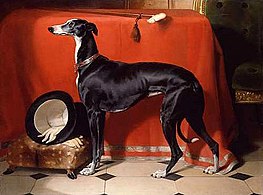
Eos, A Favorite Greyhound of Prince Albert
-

-
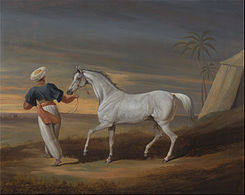
Signal, a Grayness Arab, with a Groom in the Desert
-

-

-

-
See as well
- Alternative pets:
- Digital pet
- Exotic pet
- Robotic pet
- Fauna captivity
- Creature hoarding
- Fauna roleplay
- Anthrozoology
- Dog attack
- Dog preparation
- Dogs portal
- Domestication
- Human involvement story
- List of dog breeds
- Pet adoption
- Pet cloning
- Pet first assist
- Pet nutrient
- Pet insurance
- Pet loss:
- Animal loss
- Pet cemetery
- Rainbow Bridge (pets)
- Pet passport
- Pet sitting
- Pet store
- Pet travel
- Popular cat names
- Veterinary medicine
- Zoonosis
References
- ^ "Position Statement on Buying/Guardianship". ASPCA . Retrieved seven November 2021.
- ^ a b Leslie, Be; Meek, Ah; Kawash, Gf; Mckeown, Db (April 1994). "An epidemiological investigation of pet ownership in Ontario" (Gratis total text). The Canadian Veterinary Journal. 35 (iv): 218–22. ISSN 0008-5286. PMC1686751. PMID 8076276.
- ^ McRobbie, Linda Rodriguez (1 August 2017). "Should we finish keeping pets? Why more and more ethicists say yes". The Guardian . Retrieved 3 Baronial 2017.
- ^ Tang, Ailin; Bradsher, Keith (22 October 2018). "The Trade War's Latest Casualties: Communist china'southward Coddled Cats and Dogs". New York Times . Retrieved 23 October 2018.
- ^ "China Pet population and ownership 2019 update". Red china Pet Marketplace. 25 Dec 2018. Retrieved 25 August 2019.
- ^ "Main_Page45 milioni gli animali domestici in Italia: 150.000 ogni anno vengono abbandonati". Il Messaggero. 22 September 2009. Archived from the original on eleven July 2013.
- ^ "Great britain domestic true cat and dog population larger than idea". University of Bristol. half-dozen February 2010.
- ^ "More true cat owners 'have degrees' than domestic dog-lovers". BBC News Online. 6 February 2010.
- ^ "Facts + Statistics: Pet statistics | Iii". world wide web.iii.org . Retrieved 25 August 2019.
- ^ a b http://world wide web.shea-online.org/Portals/0/PDFs/Animals%20in%20Healthcare%20Facilities.pdf Archived 4 March 2016 at the Wayback Machine
- ^ The Humane Society of the United States. "U.Due south. Pet Ownership Statistics". Retrieved 27 April 2012.
- ^ "U.S. Pet Ownership & Demographics Sourcebook (2012)". Archived from the original on 17 February 2017. Retrieved 16 Jan 2017.
- ^ Daniel Halper (ane February 2013). "Brute Planet: Pets Outnumber Children 4 to 1 in America". The Weekly Standard. Archived from the original on iv September 2015. Retrieved 9 February 2013.
- ^ Susan Hayes. "What are the most pop pets effectually the world?". PetQuestions.com. Archived from the original on 22 October 2010. Retrieved 4 March 2011.
- ^ "Industry Statistics & Trends". American Pet Product Clan. Retrieved iv March 2011.
- ^ "Plants and Your Cat". True cat Fanciers' Association. Archived from the original on 27 December 2009. Retrieved 15 May 2007.
- ^ Langston, Cathy E. (1 January 2002). "Acute Renal Failure Caused by Lily Ingestion in Six Cats". Journal of the American Veterinary Medical Association. 220 (ane): 49–52, 36. doi:ten.2460/javma.2002.220.49. PMID 12680447.
- ^ "These plants can be poisonous to dogs". Sunset Magazine. 12 July 2010. Retrieved 17 October 2013.
- ^ Klein, Dr Jerry; Dec 10, C. V. O.; Dec 10, 2018 | two Minutes; Minutes, 2018 | 2. "Are Poinsettias Poisonous to Dogs?". American Kennel Club . Retrieved 26 Baronial 2019.
{{cite web}}: CS1 maint: numeric names: authors list (link) - ^ "Overweight Dogs". Pet Intendance. The American Order for the Prevention of Cruelty to Animals (ASPCA). Retrieved 17 Oct 2013.
- ^ "Overweight Cats". Pet Care. The American Society for the Prevention of Cruelty to Animals (ASPCA). Retrieved 17 October 2013.
- ^ Zelman, Joanna (23 February 2011). "Pet Obesity: Over Half Of U.Southward. Dogs And Cats Are Overweight, Study Says". Huffington Post . Retrieved 17 October 2013.
- ^ a b "Pets are a kid'due south all-time friend, right? Maybe not, study says". Philadelphia Inquirer . Retrieved 27 December 2017.
- ^ a b c d "The Wellness Benefits of Pets". U.s. Authorities National Institute of Health. Retrieved 25 December 2006.
- ^ "Pets Are Good For Us—But Non In The Ways Nosotros Recall They Are". National Geographic. 25 November 2017. Retrieved 27 December 2017.
- ^ a b "Largest-Ever Study of Pets and Kids' Wellness Finds No Link; Findings Dispute Widely Held Behavior Virtually Positive Effects of Pet Ownership". RAND. Retrieved 27 December 2017.
- ^ a b Reiman, Steve. "Therapy Dogs in the Long-Term Wellness Care Environment" (PDF). Archived from the original (PDF) on 6 May 2012. Retrieved 27 April 2012.
- ^ a b c Whiteley, Ellen H. (1986). "The Healing Power of Pets". Vol. 258, no. vii. Saturday Evening Post. pp. 2–102. Retrieved v November 2006. Academic Search Elite. EBSCOhost. Polk Library, UW Oshkosh
- ^ Bos, Eastward.H.; Snippe, East.; de Jonge, P.; Jeronimus, B.F. (2016). "Preserving Subjective Wellbeing in the Face of Psychopathology: Buffering Effects of Personal Strengths and Resource". PLOS I. 11 (3): e0150867. Bibcode:2016PLoSO..1150867B. doi:x.1371/periodical.pone.0150867. PMC4786317. PMID 26963923.
- ^ Asp, Karen (2005). "Volunteer Pets". Prevention. 57 (4): 176–78. Retrieved 5 November 2006. Academic Search Elite. EBSCOhost. Polk Library, UW Oshkosh
- ^ Allen, Thou; Shykoff, Be; Izzo, Jl, Jr (one October 2001). "Pet ownership, but not ace inhibitor therapy, blunts home blood pressure responses to mental stress". Hypertension. 38 (four): 815–20. doi:10.1161/hyp.38.4.815. ISSN 0194-911X. PMID 11641292.
{{cite journal}}: CS1 maint: multiple names: authors list (link) - ^ Kingwell, Ba; Lomdahl, A; Anderson, Wp (October 2001). "Presence of a pet canis familiaris and human cardiovascular responses to mild mental stress". Clinical Autonomic Research. eleven (5): 313–7. doi:10.1007/BF02332977. ISSN 0959-9851. PMID 11758798. S2CID 40206732.
- ^ Wilson, Cc (Oct 1987). "Physiological responses of college students to a pet". The Journal of Nervous and Mental Disease. 175 (10): 606–12. doi:ten.1097/00005053-198710000-00005. ISSN 0022-3018. PMID 3655768. S2CID 2188860.
- ^ Koivusilta, Leena Thou.; Ojanlatva, A; Baune, Bernhard (2006). Baune, Bernhard (ed.). "To Have or Not To Have a Pet for Better Health?". PLOS ONE. i (i): e109. Bibcode:2006PLoSO...1..109K. doi:ten.1371/journal.pone.0000109. PMC1762431. PMID 17205113.
- ^ Vormbrock, Jk; Grossberg, Jm (Oct 1988). "Cardiovascular furnishings of human–pet dog interactions". Periodical of Behavioral Medicine. 11 (v): 509–17. doi:10.1007/BF00844843. ISSN 0160-7715. PMID 3236382. S2CID 25544682.
- ^ Dembicki, D and Anderson, J. 1996. Journal of Nutrition in Gerontology and Geriatrics. Book 15 Upshot 3, pages 15-31.
- ^ Jodee (8 July 2010). "Want to Reduce Risk of Centre Disease? Go a Pet". Archived from the original on 27 March 2013. Retrieved 27 April 2012.
- ^ Friedmann E, Galik Due east, Thomas SA, Hall PS, Chung SY, McCune Southward. Evaluation of a Pet-Assisted Living Intervention for improving functional status in assisted living residents with balmy to moderate cognitive damage. American Journal of Alzheimer's Disease and Other Dementias.2015:xxx(three):276-289
- ^ Parslow, Ruth; Jorm, Anthony; Christensen, Helen; Rodgers, Bryan; Jacomb, Patricia (Jan–February 2005). "Pet Ownership and Health in Older Adults". Gerontology. 40. 51 (ane): 40–47. doi:x.1159/000081433. PMID 15591755. S2CID 21851049.
- ^ Farlex. "The Free Dictionary By Farlex". Retrieved 27 April 2012.
- ^ Reinman, Steve. "Therapy Dogs in the Long-Term Health Care Environs" (PDF). Archived from the original (PDF) on six May 2012. Retrieved 27 April 2012.
- ^ Huculak, Chad (4 Oct 2006). "Super Furry Animals". Edmonton: W7. . LexisNexis. Polk Library, UW Oshkosh. 5 November 2006.
- ^ Bruck, Laura (1996). "Today'southward Ancillaries, Part 2: Art, music and pet therapy". Nursing Homes: Long-Term Care Management. 45 (7): 36. Retrieved v November 2006. Bookish Search Elite. EBSCOhost. Polk Library, UW Oshkosh.
- ^ Woods L, Martin M, Christian H, Nathan A, Lauritsen C, Houghton S, Kawachi I, McCune Southward. The pet gene - Companion animals as a conduit for getting to know people, friendship formation, and social support. PLoS One. 2015:ten(4):e0122085
- ^ Irvine, Leslie (2013). My Dog Always Eats Showtime: Homeless People and Their Animals. Boulder, CO: Lynne Rienner Publishers, Inc.
- ^ "In the Home, a Four-Legged Tripwire". The New York Times. 27 March 2009.
- ^ "Nautical chart of signatures and ratifications of Treaty 125. European Convention for the Protection of Pet Animals". Council of Europe. Retrieved iv June 2020.
- ^ "About Usa". NhRP Website. Nonhuman Rights Project. Archived from the original on 26 June 2012. Retrieved 29 August 2013.
- ^ "About IDA". IDA Website. In Defense of Animals. Retrieved 29 August 2013.
- ^ "Fauna Rights Uncompromised: 'Pets'". PETA Website. People for the Ethical Handling of Animals. 24 June 2010. Retrieved 21 September 2012.
- ^ Garner, Robert. "A Defense force of a Broad Animal Protectionism," in Francione and Garner 2010, pp. 120–121.
- ^ Francione, Gary Lawrence (1996). Rain without thunder: the ideology of the animate being rights movement. ISBN978-i-56639-461-1.
- ^ Francione, Gary. Animals, Property, and the Police force. Temple University Press, 1995.
- ^ Garner 2005, p. 15; besides see Singer, Peter. Animal Liberation, Random House, 1975; Regan, Tom. The Case for Fauna Rights, University of California Press, 1983; Francione, Gary. Animals, Property, and the Police. Temple University Press, 1995; this paperback edition 2007.
- ^ "Do You Alive in a Guardian Community?". The Guardian Entrada. Retrieved 1 September 2013.
- ^ Nolen, R. Scott (ane March 2005). "At present, it'south the lawyers' plow". Journal of the American Veterinary Medical Clan . Retrieved 29 August 2013.
- ^ Chapman, Tamara (March–April 2005). "Owner or Guardian?" (PDF). Trends Magazine . Retrieved 29 August 2013.
- ^ Katz, Jon (5 March 2004). "Guarding the Baby-sit Dogs?". Abode / Heavy Petting: Pets & People. Slate. Retrieved 29 Baronial 2013.
- ^ Sharon Dijksma (28 January 2015). "Kamerbrief invoering huisdierenlijst zoogdiersoorten". Rijksoverheid.nl (in Dutch). Dutch Government. Retrieved 18 May 2020.
- ^ "Een rendier mag dan weer wel". Trouw (in Dutch). 3 Dec 2013. Retrieved 18 May 2020.
- ^ Rijksoverheid / ANP (31 January 2017). "Lijst 2017 bekend: welke dieren mag jij als huisdier houden?" (in Dutch). BNNVARA. Retrieved 19 May 2020.
- ^ jrosquin (five January 2011). "Uw kat opeten is wettelijk toegestaan". Gazet van Antwerpen (in Dutch). Retrieved 4 June 2021.
- ^ "Zelf doden huisdieren vanaf vandaag verboden". RTL Nieuws (in Dutch). 1 July 2014. Retrieved iv June 2021.
- ^ a b Okin, Gregory Due south. (2 August 2017). "Environmental impacts of food consumption by dogs and cats". PLOS ONE. 12 (8): e0181301. Bibcode:2017PLoSO..1281301O. doi:x.1371/journal.pone.0181301. ISSN 1932-6203. PMC5540283. PMID 28767700.
- ^ Farlex. "The Complimentary Dictionary by Farlex". Retrieved 27 April 2012.
- ^ Clutton-Brock, Juliet (1995). "Origins of the dog: domestication and early on history". In Serpell, James (ed.). The domestic dog: its evolution, behaviour and interactions with people . Cambridge: Cambridge University Press. pp. 10–11. ISBN9780521425377.
- ^ Messenger, Stephen (xiii June 2014). "9 Touching Epitaphs Ancient Greeks And Romans Wrote For Their Deceased Dogs". The Dodo . Retrieved 18 January 2019.
- ^ Anthony L. Podberscek; Elizabeth S. Paul; James A. Serpell (21 July 2005). Companion Animals and U.s.a.: Exploring the Relationships Between People and Pets. Cambridge Academy Printing. p. 31. ISBN978-0-521-01771-8.
- ^ Mertz, Barbara (1978). Cerise Country, Blackness Land: Daily Life in Ancient Egypt. Dodd Mead.
- ^ Amato, Sarah (2015). Beastly Possession: Animals in the Victorian Consumer Culture. Toronto: Academy of Toronto Press. p. 25.
- ^ Amato, Sarah (2015). Beastly Possessions: Animals in Victorian Consumer Culture. University of Toronto Press. p. 6.
- ^ Ritvo, Harriet (1987). The Animal Manor: The English and Other Creatures in the Victorian Age. Cambridge: Harvard University Press. p. 86.
- ^ Amato, Sarah (2015). Abominable Possession: Animals in Victorian Consumer Culture. Toronto: University of Toronto Press. p. 48.
- ^ Philo, Chris (1989). Animal Infinite, Beastly Places: New Geographies of Man-Fauna Relations. Routledge. pp. 38–389.
- ^ Philo, Chris (1989). Animate being Space, Abominable Places: New Geographies of Man-Animal Relations. Routledge. p. 41.
- ^ Amato, Sarah (2015). Abominable Possession: Animals in Victorian Consumer Culture. Toronto: Academy of Toronto Press. p. 55.
- ^ Amato, Sarah (2015). Abominable Possession: Animals in Victorian Consumer Culture. Toronto: University of Toronto Press. p. ten.
- ^ Ritvo, Harriet (1987). The Animal Manor: The English and Other Creatures in the Victorian Era. Cambridge: Harvard University Printing. p. 104.
- ^ Ritvo, Harriet (1987). The Animal Estate: The English and Other Creatures in Victorian Age. Cambridge: Harvard University Press. pp. seven–8.
- ^ Ritvo, Harriet (1987). The Animal Estate: The English and Other Creatures in the Victorian Age. Cambridge: Harvard University Press. p. 98.
- ^ Ritvo, Harriet (1987). The Animal Estate: The English and Other Creatures in the Victorian Historic period. Cambridge: Harvard University Press. p. 66.
- ^ Ritvo, Harriet (1987). The Animal Estate: The English and Other Creatures in the Victorian Age. Cambridge: Harvard University Press. p. 104.
- ^ Herzog, Harold A. (2014). "Biology, Culture, and the Origins of Pet-Keeping". Animal Behavior and Noesis. 1 (three): 296. doi:ten.12966/abc.08.06.2014. ISSN 2372-4323.
- ^ a b c d Bradshaw, J. W. Due south.; Paul, Due east. S. (2010). "Could empathy for animals take been an adaptation in the evolution of Homo sapiens?" (PDF). Fauna Welfare. nineteen (Southward): 107–112. S2CID 55412536. Archived from the original (PDF) on 3 March 2019. Retrieved 3 September 2019.
- ^ a b "Are Humans the Just Animals That Keep Pets?".
- ^ Clutton-Brock, Juliet (30 October 2014). The Walking Larder: Patterns of Domestication, Pastoralism, and Predation. Routledge. pp. 16, xix. ISBN9781317598381.
- ^ a b c Salmon, Catherine; Shackelford, Todd K. (27 May 2011). The Oxford Handbook of Evolutionary Family Psychology. Oxford Academy Printing, USA. p. 299. ISBN9780195396690.
- ^ Grayness, Peter B.; Young, Sharon M. (1 March 2011). "Human–Pet Dynamics in Cross-Cultural Perspective". Anthrozoös. 24 (one): 18, 27. doi:10.2752/175303711X12923300467285. ISSN 0892-7936. S2CID 144313567.
Farther reading
- David Grimm (2015). Citizen Canine: Our Evolving Relationship with Cats and Dogs. PublicAffairs. ISBN978-1610395502.
External links
- Companion Animal Demographics in the United States: A Historical Perspective from The State of the Animals Two: 2003
-
 Quotations related to Pet at Wikiquote
Quotations related to Pet at Wikiquote
| | Wikimedia Commons has media related to Pets. |
| | Look upward pet in Wiktionary, the costless lexicon. |
Source: https://en.wikipedia.org/wiki/Pet
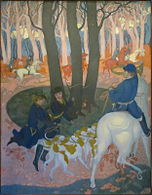
0 Response to "Any Kind of Animals That Live in Africa Baby Puppies for Sale"
Post a Comment